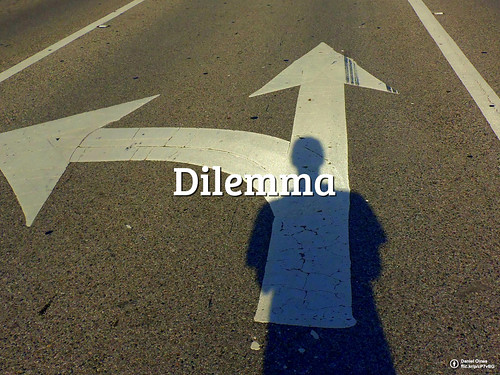 |
| Can prolonged cognitive dissonance produce self-directed behaviours? |
The following was written as part of my school studies, where I am trying to link the concepts of cognitive dissonance and displacement behaviours, such as hair pulling. Hopefully, it sheds some light on how being caught in two minds functions in different ways.
Within the wide
field of psychology are two concepts known as displacement behaviour.
Originally, Freud coined the term
displacement behaviour to refer
to libidinal impulses which are channeled
towards objects when the actual or natural object of desire has been blocked,
or its attainment prevented. He
identified fetish objects which are invested in sexualised meaning and
significance separate from their cultural value as objects of utility or
aesthetic satisfaction. The other concept referred to as displacement behaviour
is derived from the field of ethology, and in particular the work of ethologist
Niko Tinbergen. He was one of the first
to study how animals caught between two contradictory impulses can manifest
modes of behaviour that seemingly bear no relevance to the situation in which
the animal finds itself. Since then
there have been a number of animal studies that reveal displacement behaviours
across a range of species, including humans too.
In nature, displacement behaviour has been observed as
a naturally occurring event that marks a
transition. For example, Tinbergen observed apparently
inexplicable fanning movements by male
stickleback fish in a certain proximity to each
other. Tinbergen realised that this
fanning marked
the territorial boundary line between the two fish and
the tipping point between aggression (approach behaviour)
and retreat (withdraw behaviour). In nature,
displacement activities are short-term responses to
temporary frustrations which soon resolve themselves
(e.g. they end when conflict with a
potential aggressor is avoided).
In a domestic context, I have often observed how cats
manifest grooming behaviours when they are
thwarted in their attempt to achieve a goal state,
such as obtaining food. A hungry cat
presented
with an empty dish or a dish of food it does not find
appetising will commonly begin to groom itself
prior to repeating the cycle of seeking food once
again. It would seem then that
displacement
behaviour exists to calm an excited animal when the
situation falls short of what is expected,
or in some way thwarts its desire, or only partially
fulfills an internal criteria for
activating an automatic species-specific response. This
partial activation implies
that two impulses are possibly occurring together and
a third behaviour is needed to reduce
the discomfort until the situation changes and the
goal state can be attained.
The most common forms of displacement behaviour are
found in captive animals, often in laboratory
settings. Here
species-specific behaviours may not be supported by the artificial
environmental
conditions. For
example, animals may not have enough space to regulate their natural range of
proximity
from animals or humans and be unable to avoid/hide or
use aggression to ward off an unwanted human
or animal presence.
Other typical situations involve being housed with siblings so that
sexual impulses
served by approach behaviour are equally met by the
need to avoid incest. Typically, mice in
these conditions either bite their siblings' fur or
their own.
Self-directed behaviours have been particularly highlighted
as indicators of displacement activity.
Laboratory studies show that self-directed hair
pulling is common in many animals, including cats,
mice, rats, sheep, parrots and rhesus monkeys which
have been kept in captive conditions and/or
where outlets for species-typical behaviours have not
been incorporated (Akgul et al, 2000),
(Bordnick et al, 1994), (Chiezey, 2010), (Garner et
al. 2004,2006),(Reinhardt 2005).
However, in natural habitats such self-directed
behaviour has not been reported, possibly indicating
that the disorder reveals a disturbance in the
organism’s relationship to its social and ecological
environment.
Perhaps the activity may help switch off the evolved response (e.g.
fight or flight
response, seeking or vigilance etc) and reduce anxiety
by switching attention away from the source
of stress. It
should be emphasised again that displacement activities are not necessarily
pathological
and do occur in nature but not for prolonged
periods. But it is when the conditions
behind the
displacement action are prolonged or permanent that it
can become stereotypical.
In
humans, displacement activity is an everyday occurrence. It is manifested in chin rubbing, gaze
aversion,
hair manipulation, scratching or coughing.
For example, a person caught in two minds
between
going in one direction or another will commonly manifest a behaviour such as
chin scratching
as a
way of limiting the agitation that comes with his temporary confusion. However, a more stereotypical form of such
behaviour may be found in the condition known as
trichotillomania,
or hair pulling disorder (Christenson et al. 1999). This is where a person seeks out suitable
hairs to pull from their scalp or body, often as a means to obtaining a lipid
fat sebum hair root before eating it.
Over time this condition can create bald patches and is known to be a
behaviour that is very resistant to change.
In
comparison, Festinger's concept of cognitive dissonance is also understood as
the means by which discomfort or agitation from being in two minds about a
choice or decision can be reduced. In this respect cognitive dissonance can be
viewed as an inverted process of displacement behaviour. By this I mean that displacement behaviour emerges
in response to a situation that is being endured in the present moment and
involves a certain level of anticipation towards attaining a future goal state.
However,
cognitive dissonance appears to relate to the discomfort of hindsight, of
attempting to adapt to a situation where the goal state has to some extent been
attempted but not to a satisfactory degree.
This may produce a persistent sense of failure, a sense of achieving a
non-optimal outcome that cannot be altered; and with no way to reverse time or
the decision-making process this creates a mode of distinct internal or
cognitive discomfort. For example, a
football fan who expects his team to score in a high pressure game, only to see
the ball narrowly miss the goal may run his hands through his hair in
exasperation. But the expectation of
scoring remains ongoing, and he anticipates that there will be further chances
later in the match. Only after the game has ended, when there are no more
opportunities for scoring, will he experience cognitive dissonance as he
attempts to reconcile his disappointment in his team's performance with his
passionate belief that his team are special and superior to the opposition.
Interestingly,
as far as I know, Festinger never identified any accompanying physical
manifestations
of
cognitive dissonance. The resolution of
the discomfort was achieved from inside out, not outside inwards. In other words, by changing one or both of
the cognitions, or introducing a new one the agitation could be reduced
(Hewstone et al.,2012) But whether the
process of changing or introducing new cognition leads to chin rubbing, hair
pulling or skin scratching is not something which appears to be Festinger's
focus. I would suggest that (from outside inwards) external physical
stimulation is a form of homeostasis, when there is no social means by which
the agitation can be avoided, such as asking a car passenger which direction
one should drive. But I would add that where cognitive dissonance occurs for a
prolonged period of time, some form of physical manifestation would also be
apparent.
In
examining some similarities and differences between displacement behaviour and
cognitive dissonance I would suggest that both phenomenon seek the same
outcomes via different means to the problems of internally felt discomfort. Ultimately, this outcome involves adapting to
the prevailing situation as a means to moving forwards; it safeguards against
an organism becoming stuck for too long in one mode of being or becoming rooted
in the past. In other words, both
processes are necessary for mental health and reveal the emergent nature of
human experience.
Bibliography
Akgul, Y.,
Agaoglu, Z.T., Kaya, A., Sahin, T., (2000) The relationship between the
syndromes of wool eating and alopecia in Akkaraman and Morkaraman sheep fed
corn silage and blood changes (haematological, biochemical and trace elements).
Israel Journal of Veterinary Medicine 56: 23-37.
Azrin, N.H., Nunn,
R.G. (1977) Habit control in a day (New York, Simon and Schuster)
Berridge, K.C.,
Fentress J.C. and Parr H., (1987): Natural syntax rules control action sequence
of rats. Behav Brain Res 23: 59-68.
Bohne et al., (2005) Visuospatial abilities, memory, and executive
functioning in trichotillomania and obsessive-compulsive disorder, J. Clin.
Exp. Neuropsychol. 27 (4), pp. 385–399.
Bordnick P.S., Thyer B.A., Ritchie B.W., (1994) Feather picking
disorder and trichotillomania: an avian model of human psychopathology, J.
Behav. Ther. Exp. Psychiatry 25 (3) (1994), pp. 189–196.
Chiezey, N.P.
(2010) Hair pulling in confined sheep
fed a finely ground ration: case report Livestock Research for Rural
Development 22 (3).
Christenson, G.A., Mansueto, C.S., (1999) Trichotillomania:
descriptive statistics and
phenomenology. In: Stein, D.J., Christenson, G.A., Hollander, E.
(Eds.), Trichotillomania.
American Psychiatric Press, Washington, pp. 1–41.
Deluca AM (1997): Environmental enrichment: does it reduce barbering
in mice?
AWIC Newsletter 8:7-8.
DSM-IV, (1994)
Diagnostic and Statistical Manual of Mental Disorders IV (DSM-IV), American
Psychiatric Association
Fentress JC
(1968): Interrupted ongoing behaviour in
voles (Microtus agrestis and Clethrionomys britannicus) II. Anim Behav 16:
154-67.
Fentress JC
(1991): Analytical ethology and synthetic neuroscience. In: Bateson P, ed., The Development and
Integration of Behaviour. Cambridge:
Cambridge University Press, pp. 77-120.
Fraser A. F.
(1995) Sheep. In: The Experimental Animal in Biomedical Research. Volume II –
Care, Husbandry, and Well-Being (Rollin B E, Kesel M L eds editors). Boca
Raton, FL: CRC Press, 87–118.
Freud, S (1975) Introductory
Lectures On Psychoanalysis. Lecture 25: Anxiety pp. 440-60 (Penguin)
Galski, T. (1983) Hair Pulling (Trichotilllomania), Psychoanal Rev,
Vol. 70, 3, 331-46.
Garner, J. P., Weisker, S. M., Dufour, B., & Mench, J. A.
(2004). Barbering (fur and whisker trimming)
by laboratory mice as a model
of human trichotillomania and obsessive-compulsive spectrum disorders.
Comparative Medicine, 54, 216–224.
Garner, J. P., Meehan, C. L., Famula, T. R., & Mench, J. A.
(2006). Genetic, environmental, and
neighbor effects on the severity of stereotypies and feather picking
in Orange-winged Amazon
parrots (amazona amazonica):
An epidemiological study.
Applied Animal Behaviour Science, 96, 153–168.
Hall, F.S., Wilkinson,
L.S., Humby, T. et al. (1998) Isolation rearing in rats: pre- and post-synaptic
changes in striatal doperminergic systems, Pharmacol Biochem Behav 59:859-72.
Hewstone, M,
Stroebe, W., Jonas, K., (2012) An Introduction to Social Psychology, Fifth Edition
(Blackwell, Chichester)
Kalueff, A.V.,
Laporte, J.L., Bergner, C.L. (2010): Neurobiology of Grooming Behaviour
(Cambridge University Press)
Moberg,G.P, Mench, J.A, (2001) The Biology of Animal Stress: basic
principles and implications for
animal welfare (CABI publishing, Wallingford/New York)
Moon-Faneli, A.A, Dodman, N.H., and R.L. O'Sullivan, R.L. (1999)
Veterinary models of compulsive
self-grooming:
Reinhardt, V. (2005). Hair pulling: A review. Laboratory Animals,
39, pp.361–369.
Reinhardt V, Reinhardt A, Houser D. (1986) Hair pulling and eating
in captive rhesus monkey troops
Folia Primatol (Basel) 47(2-3):158-64.
Robbins, T.W., Jones, G.H., Wilkinson L.S. (1996)Behavioural and
neurochemical effects of early
social deprivation in the rat, Journal of Psychopharmacology
10:39-47.
Schrijver N.C.A., Wűrbel, H.: (2001) Early social deprivation disrupts
attentional, but not affective, shifts in rats. Behav Neurosic 115: 437-42.
Winnicott, D.W.,
(1971) Playing and Reality (Tavistock
Publications)
Wűrbel H (2001): Ideal homes? Housing effects on rodent brains and
behaviour.
Trends Neurosci 24:207-11.





